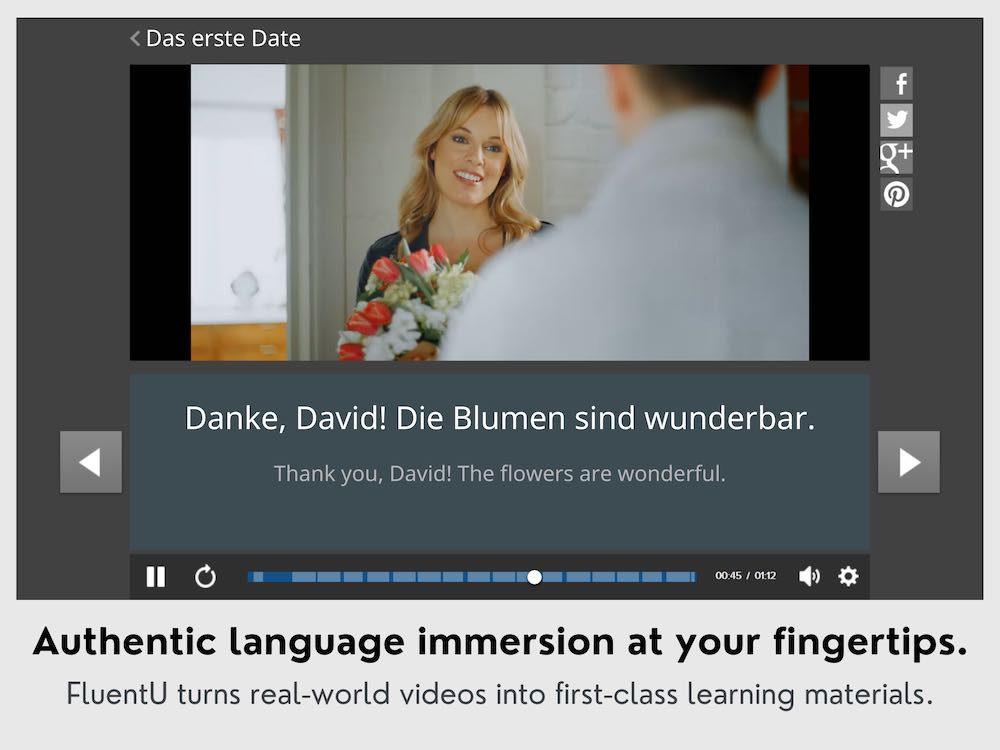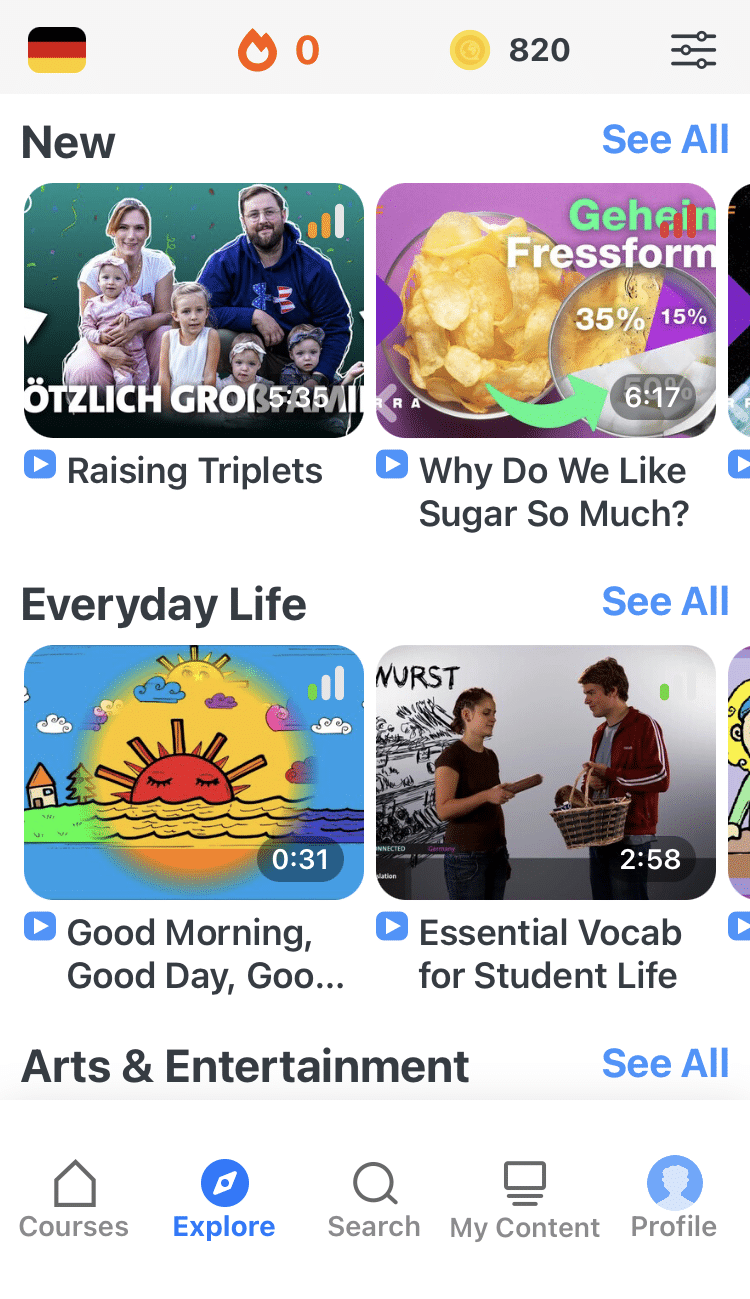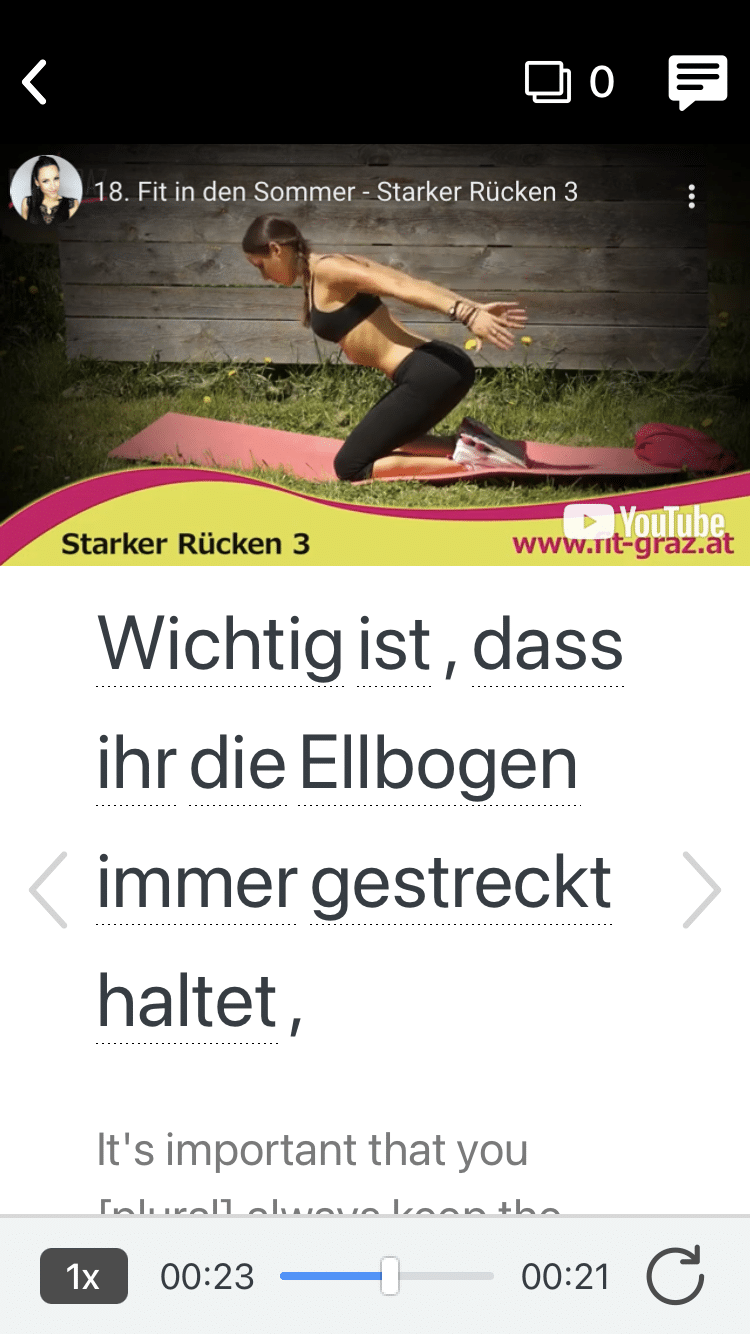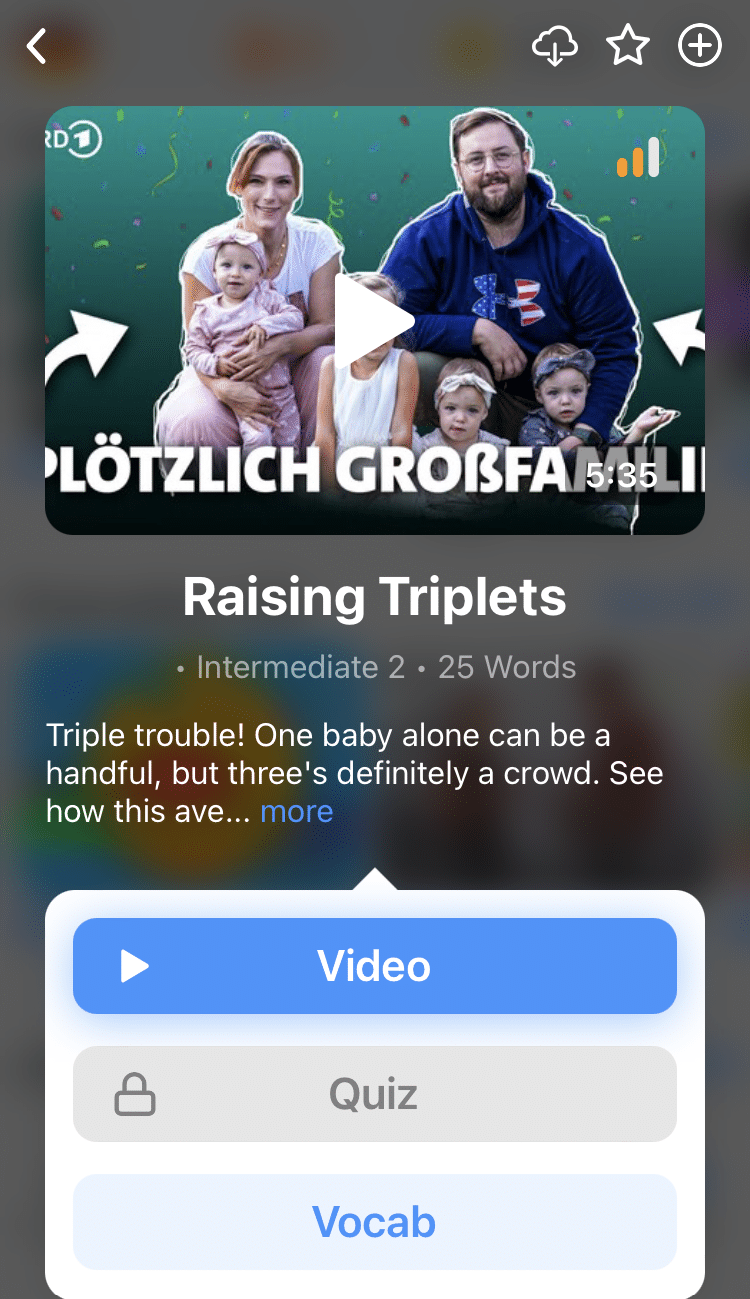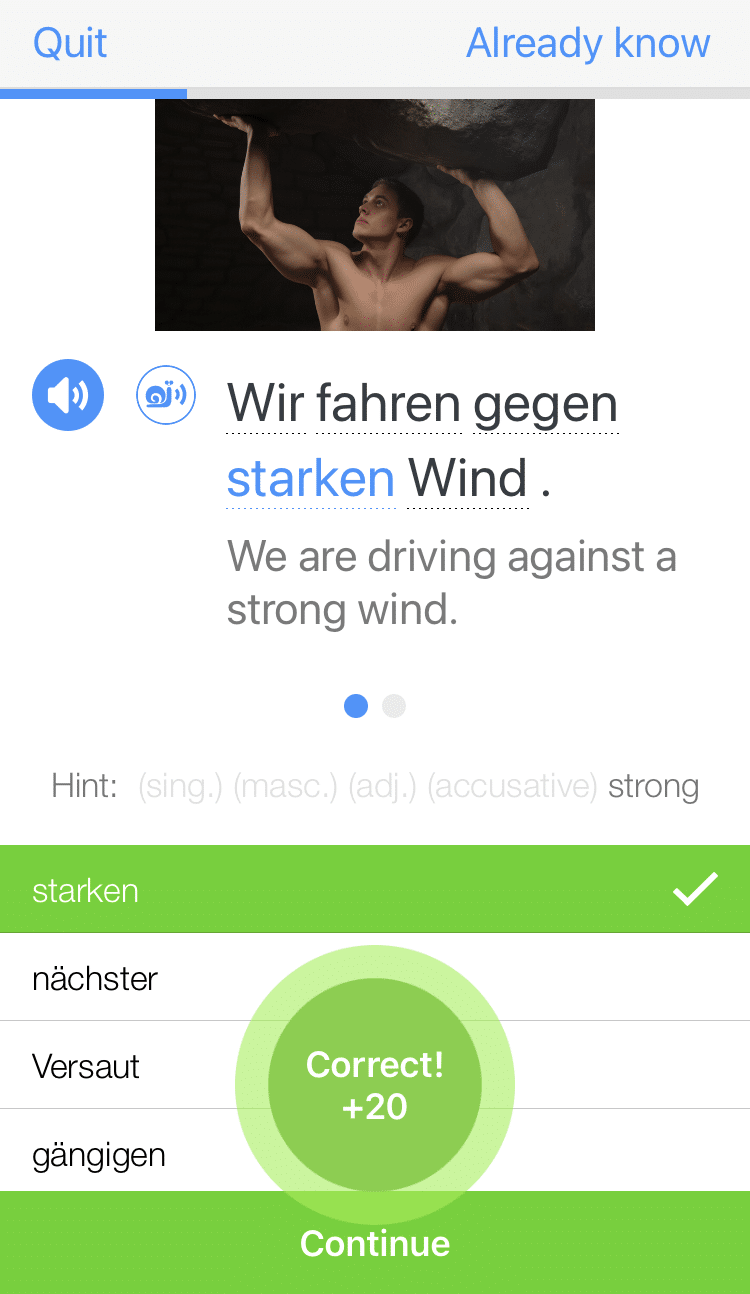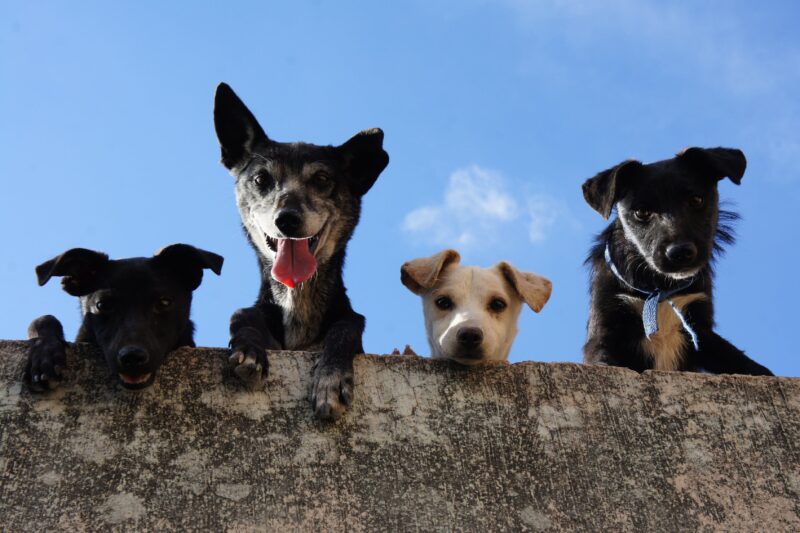
48 German Dog Commands for Both You and Your Pet to Learn
Are you learning German and looking to learn and practice new German words with your dog?
If yes, then we have great news for you—and Rex or Fido, too!
In this post, we’ll show you exactly how you can learn German with dog commands, Hundekommandos, and teach you 48 of the most common commands.
Contents
- 1. Fetch — Bring / Apport
- 2. Drop it / Let go — Aus
- 3. Sit — Sitz
- 4. Stay — Bleib
- 5. Down — Platz
- 6. Go to your place — Auf deinen Platz
- 7. Heel — Fuß / Bei Fuß
- 8. Here — Hier
- 9. Come here — Komm
- 10. Wait — Warte
- 11. Go — Los
- 12. Go / Run — Lauf
- 13. Speak — Gib Laut
- 14. Quiet — Ruhig
- 15. No — Nein
- 16. Yuck — Pfui
- 17. Stop — Stopp / Halt
- 18. Enough — Genug
- 19. Treat — Leckerli
- 20. Search — Such
- 21. Onwards — Weiter
- 22. Left — Links
- 23. Right — Rechts
- 24. Paw / Shake — Gib Pfötchen
- 25. Gimme five — Gib fünf
- 26. Good dog — Braver Hund
- 27. Jump — Spring / Hopp
- 28. Go potty — Mach Pipi / Mach Geschäft
- 29. Spin / Twirl — Dreh dich
- 30. Stand up — Steh auf
- 31. Give a kiss — Gib Küsschen
- 32. Attack — Fass
- 33. Find the leash — Such die Leine
- 34. Back / Back up — Zurück
- 35. Stand up — Aufstehen
- 36. Roll over — Rolle
- 37. Crawl — Kriech
- 38. Through / Weave — Slalom
- 39. Play dead — Peng / Tot stellen
- 40. Gentle — Vorsichtig
- 41. Outside — Raus
- 42. Inside — Komm rein
- 43. Watch out — Pass auf
- 44. Be nice — Sei nett
- 45. Howl — Heule
- 46. Slow — Langsam
- 47. Quick — Schnell
- 48. Off to bed— Ins Bett
- Why Train Your Dog with German Dog Commands?
- And One More Thing...
Download: This blog post is available as a convenient and portable PDF that you can take anywhere. Click here to get a copy. (Download)
1. Fetch — Bring / Apport
If you throw a ball for your dog and want him to bring it back to you, then the German dog command you need is bring. This word comes from the German verb bringen which, you guessed it, means “bring,” or in this case “fetch,” in English.
You can also use the fancier version apport, which comes from French.
2. Drop it / Let go — Aus
In German, aus is a preposition meaning “out of.” As it tends to be used to get a dog to stop clinging on to something with its teeth, you can think of it as asking your pooch to let said object go “out” of its mouth.
3. Sit — Sitz
To teach your dog this German command, just add a z to the end of the English verb “sit” to make sitz. Sitz comes from the German verb sitzen which means, you guessed it, “sit.”
4. Stay — Bleib
When your dog should stay put, use the German dog command bleib. This command comes from the German verb bleiben which means “stay” or “remain.”
5. Down — Platz
Platz is a noun that means “town square,” “space” or “seat.” In this case, it’s short for Platz nehmen or “take a seat.” You can use this when you want your dog to lie down.
6. Go to your place — Auf deinen Platz
With this one, you can direct your dog to move to its bed or designated spot. This command combines auf (to) with deinen Platz (your place).
7. Heel — Fuß / Bei Fuß
Fuß is a handy German dog command to use while working with your dog on his or her leash-walking skills. Fuß or bei Fuß is a noun that literally means “foot,” as in your pal should walk by or behind your feet, not charge ahead!
8. Here — Hier
When you want your dog to come over and give you some love or come back if he or she has run off to greet another dog with a friendly sniff, then shout hier.
9. Come here — Komm
Here’s another one whose English counterpart is similar in both meaning and pronunciation. Kommen is a verb that means “to come.”
10. Wait — Warte
Signal your dog to pause momentarily with this command. Warte instructs your pup to wait, derived from the German verb warten or “to wait.”
11. Go — Los
The command los motivates your furry companion to start an action. Los is often used to mean “let’s go” in German. With your dog, you can go use it before going for a walk, for example.
12. Go / Run — Lauf
Want to see your dog take off like a streak of lightning? Lauf comes from the German verb laufen which means both “walk” and “run.”
13. Speak — Gib Laut
If you want your dog to bark, then learn the German dog command Gib Laut. Gib is the imperative version of the German verb geben, “to give,” and Laut is an adjective that means “loud.”
14. Quiet — Ruhig
Command your dog to stop barking or remain calm. Ruhig instructs your canine friend to be quiet or composed, derived from the German adjective for “calm” or “quiet.”
15. No — Nein
When your dog is being bad—or obviously thinking about it—sometimes all you have to do is say a quick nein (no) to bring him back in line.
16. Yuck — Pfui
What about those times when they’re determined to put something super gross in their mouth as though it were a piece of tasty candy? Teach your pooch the German command pfui, which is an interjection similar in meaning to “yuck,” “ugh” or “eww.”
17. Stop — Stopp / Halt
Stopp and halt are both common German interjections for “stop” and “halt,” more words that are similar in English. The verb forms are stoppen and halten.
18. Enough — Genug
Use genug to indicate that your dog should stop doing something, like perhaps jumping up on a stranger. The command conveys a clear boundary and is a German adjective meaning “enough.”
19. Treat — Leckerli
After all the training you do together, don’t forget to give your furry friend plenty of Leckerlis (treats), not to mention a ton of praise—but in German of course!
20. Search — Such
Looking to train your German-loving dog to search and rescue or maybe to just help you find your keys? In that case, train him or her with the German dog command such, which comes from the German verb suchen (search/look for).
Some dogs are trained to such for drugs, bombs and even trapped or missing people. Watch a German clip about one type of these working dogs on FluentU.
FluentU takes authentic videos—like music videos, movie trailers, news and inspiring talks—and turns them into personalized language learning lessons.
You can try FluentU for free for 2 weeks. Check out the website or download the iOS app or Android app.
P.S. Click here to take advantage of our current sale! (Expires at the end of this month.)
21. Onwards — Weiter
You can use this one when your dog likes to stop and sniff around a lot. Instead of pulling or jerking the leash, try using this command. Weiter literally means “further” or “continue.”
22. Left — Links
Instruct your dog to move to the left with the command links. This straightforward direction utilizes the German word for “left.”
23. Right — Rechts
Guide your dog to move to the right using the command rechts. This command uses the German term for “right.”
24. Paw / Shake — Gib Pfötchen
Pfötchen is the diminutive form of the word Pfote (paw), which means that the literal translation of this command is “Give me your little paw.” Awww, thanks, buddy!
25. Gimme five — Gib fünf
Every cool dog knows a trick like “gimme five.” Teach your bilingual dog to high-five using the German dog command Gib fünf. Gib is the imperative of geben, or “to give,” and fünf is “five.”
You’ll also hear German dog owners simply using the English “high five” too.
26. Good dog — Braver Hund
The German phrase for “good dog” is braver Hund, or you could go for braves Mädchen (good girl) or braver Junge (good boy).
Curious as to why the ending to the word brav (good/well-behaved) sometimes ends in -er and sometimes in -es? Don’t forget to go back and review the rules for German adjective endings!
27. Jump — Spring / Hopp
Prompt your dog to leap with the commands spring or hopp. Both words convey the action of jumping, with spring from springen (to jump) being more commonly used in standard German and hopp being a colloquial variant.
28. Go potty — Mach Pipi / Mach Geschäft
Instruct your dog to relieve himself with the command Mach Pipi or Mach dein Geschäft. Both phrases, translating to “go pee” or “do business,” are commonly used to encourage bathroom behavior.
29. Spin / Twirl — Dreh dich
Guide your dog to rotate, twirl or spin around using the command Dreh dich. This phrase combines dreh (turn) with dich (yourself).
30. Stand up — Steh auf
Prompt your dog to rise to a standing position with the command steh auf. This command combines steh (stand) with auf (up).
31. Give a kiss — Gib Küsschen
You can encourage affection from your dog with this one. This phrase, translating to “give a little kiss,” invites a sweet and loving gesture from your furry friend. Küsschen is a diminutive of kuss (kiss). So sweet!
32. Attack — Fass
Ok, so you probably don’t want to go around encouraging your dog to bite people, but this dog command could still come in handy for German guard dog breeds.
Fass can also be used for more harmless occasions, like when you want your pal to bite a stick for a good old game of doggie/owner tug of war. Fass is the imperative form of the German verb fassen (bite/grab).
33. Find the leash — Such die Leine
Motivate your dog to search for and bring back the leash with the command Such die Leine. This phrase combines such (search), from suchen (to search), with die Leine (the leash).
34. Back / Back up — Zurück
Guide your dog to move backward with the command Zurück. This term, meaning “back” or “backward,” encourages your pup to take a few steps in reverse.
35. Stand up — Aufstehen
Prompt your dog to rise from a sitting or lying position with the command Aufstehen. This phrase combines auf (up) with stehen (stand) and literally means “to get up.”
36. Roll over — Rolle
This simple command instructs your pup to perform the playful trick of rolling over. It comes from the word rollen or “to roll.”
37. Crawl — Kriech
This command asks your dog to crawl under an obstacle of some sort. You can instruct your furry friend to move forward in a low position, perfect for navigating under barriers like fences. The full verb kriechen means “to crawl.”
38. Through / Weave — Slalom
Named after the alpine sport, this term can be used to guide your pup through openings or obstacles, including between your legs!
39. Play dead — Peng / Tot stellen
Teach your dog to lie on its side as if playing dead with this command. Peng is an onomatopoeia referring to the “bang” sound a pistol makes when going off. So be sure to dust off your “hand” gun to teach your dog this trick.
Alternatively, you can do without the hand theater and simply use the far more literal tot stellen, which means “play dead”.
40. Gentle — Vorsichtig
Encourage your dog to be gentle in its actions with the command vorsichtig. This term, meaning “careful” or “gentle,” is useful for promoting a delicate touch.
41. Outside — Raus
Signal to your dog that it’s time to go outside! This straightforward term instructs your pup to head out.
42. Inside — Komm rein
Getting late? Time to get your dog back in the house with this command. Komm comes from the verb kommen, or “to come,” and rein means “in” or “inside”.
43. Watch out — Pass auf
Alert your dog to be cautious or attentive with this command. This phrase, meaning “watch out” or “pay attention,” prompts your pup to be vigilant.
44. Be nice — Sei nett
Encourage friendly behavior towards people or other animals with this one. This phrase, meaning “be nice,” reinforces positive social interactions. Sei is the imperative form of sein, or “to be,” and nett means “nice” or “kind.”
45. Howl — Heule
Encourage your dog to howl with this one, which comes from the word heulen. It literally means “to howl” or “to wail.” It taps into your pup’s vocal abilities and adds a fun element to your interactions.
46. Slow — Langsam
Guide your dog to move slowly with the command langsam. This term, literally meaning “slow,” is useful for controlling the pace of various activities.
47. Quick — Schnell
Encourage your dog to increase its speed with the command schnell. This term, which literally means “fast” or “quick,” is handy for activities that require a quicker pace.
48. Off to bed— Ins Bett
Signal your dog to rest or sleep with this command in German. This straightforward term instructs your pup to head to wherever they tend to sleep.
Why Train Your Dog with German Dog Commands?
- If you train your dog with German commands, you’ll be repeating the commands over and over, which will help you memorize German words, especially verbs, which you can use later at places other than the dog park.
- German dog commands are also great for building up your grammar skills. Since commands are always given in the imperative, you’ll naturally practice this verb form while telling your dog to bleib (stay) or bring (fetch).
- German dog commands are short and sweet and easy for dogs to understand, so both you and your dog will become bilingual with ease.
- Training your dog with German dog commands sounds darn cool. Speaking in German to your dog will impress your friends, not to mention that cutie—canine or otherwise—while out on a stroll!
- Many of the world’s most popular dog breeds come from Germany. German Shepherds, Rottweilers, Doberman Pinscher, Schnauzers, Dachshunds, Great Danes, and yes, even Poodles and Pomeranians among many others, all originally came from the country. If you have a German breed or mix, then why not be authentic and train them using German dog commands?
And there you have it: 48 German dog commands you can use with your pooch. The next time you’re at the dog park, you’re sure to be the envy of every canine owner around!
Download: This blog post is available as a convenient and portable PDF that you can take anywhere. Click here to get a copy. (Download)
And One More Thing...
Want to know the key to learning German effectively?
It's using the right content and tools, like FluentU has to offer! Browse hundreds of videos, take endless quizzes and master the German language faster than you've ever imagine!
Watching a fun video, but having trouble understanding it? FluentU brings native videos within reach with interactive subtitles.
You can tap on any word to look it up instantly. Every definition has examples that have been written to help you understand how the word is used. If you see an interesting word you don't know, you can add it to a vocabulary list.
And FluentU isn't just for watching videos. It's a complete platform for learning. It's designed to effectively teach you all the vocabulary from any video. Swipe left or right to see more examples of the word you're on.
The best part is that FluentU keeps track of the vocabulary that you're learning, and gives you extra practice with difficult words. It'll even remind you when it’s time to review what you’ve learned.
Start using the FluentU website on your computer or tablet or, better yet, download the FluentU app from the iTunes or Google Play store. Click here to take advantage of our current sale! (Expires at the end of this month.)
